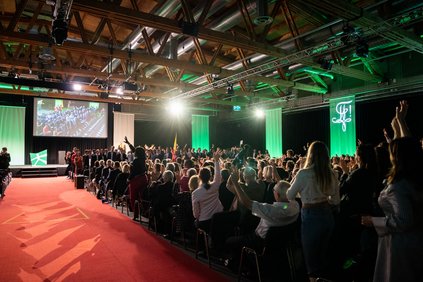Campus - 19.11.2010 - 00:00
Exhibition on sustainability
On the occasion of the World Climate Summit in Cancún, the student initiative oikos CNC has compiled an exhibition on sustainable energy policy. This exhibition can be viewed at the HSG until 13 December.
Under the heading of “EinSichten - WievielKlimabist Du?” – Insights – how much climate are you? – the initiative aims to make people aware of sustainability and climate change. “We would like to make people sensitive to this and, ideally, change their consumption behaviour,” says oikos CNC project coordinator Markus Arnold.
Energy, transport, consumption
On ten coloured posters which deal with energy, transport and consumption, individual habits are called into question and the impact of meat and fish consumption on the CO2 balance is demonstrated.
According to Irena Irmler of the oikosCNC Committee, the crucial question is, “What are the economically sensible measures with which each and every one of us is able to reduce his or her personal energy consumption?”
UN Climate Summit inCancún
The date for the exhibition was not chosen at random: about 10,000 km away, in the Mexican coastal city of Cancún, the United Nations will deliberate a new climate protection treaty at the UN Climate Summit.
After the failure of the Climate Summit in Copenhagen, where no agreement was reached, expectations are subdued. Nonetheless, HSG Professor Rolf Wüstenhagenis certain that there are also rays of hope: for one thing, there is a strong growth in renewable energies, and for another, “climate protection efforts are still being made at national, regional and local levels”.
The exhibition “EinSichten - WievielKlimabist Du?”can be viewed in the foyer of the Main Building of the University of St.Gallen until 13 December.
| What do you expect from the World Climate Summit inCancún? After the failure of the Climate Summit in Copenhagen, it is extremely unlikely that an agreement will be reached in Cancún. It already became clear in Copenhagen that the US will have difficulty committing itself to adequate emission reductions, and after the mid-term elections, the Obama Administration’s scope of action has become even smaller. In this situation, the second great emitter, China, will stick to its position and will not bindingly commit itself either. It’s like a game of Mikado: no one wants to move first. Is there an alternative to a new binding climate protection treaty? There are two rays of hope in the current situation: for one thing, climate protection efforts are still being made at national, regional and local levels. Thus a referendum in California confirmed Arnold Schwarzenegger’s climate policy against the resistance put up by industry, and the EU is also sticking to its emission targets. For another, the strong growth in renewable energies, and not least China’s rise to world market leader in wind and solar energy, also results in emission reductions. What can each and every one of us do for climate protection? The greatest climate protection potentials are to be found in transport, buildings and nutrition. My personal four-point climate protection plan, for instance, looks like this: going to work on my bicycle rather than by car, going on holiday by train if possible, eating vegetarian food, and buying electric power from renewable energies at home. This also works without Cancún :-). |
| Rolf Wüstenhagen is Professor of the Management of Renewable Energies at the IWÖ-HSG. |
Foto: Photocase / Alexander Ohrt
More articles from the same category
Discover our special topics











